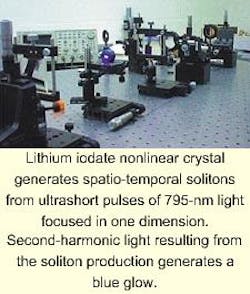
Solitons are self-contained packets of light that propagate through a nonlinear medium and, in doing so, confine themselves in at least one dimension. Temporal solitons—often already confined in their transverse directions by optical fibers—maintain their temporal shape. Spatial solitons confine themselves in one or two transverse spatial dimensions. A spatio-temporal soliton (STS) maintains its shape in time and in at least one spatial dimension.
In theory, the STS has potential application for ultrafast all-optical computing and switching. However, for years no one had been able to produce a STS in the laboratory.
Researchers at Cornell University (Ithaca, NY) have passed a beam of pulsed light through a 1-cm-long crystal of lithium iodate (LiIO3) and caused the pulses to collapse in time and in one spatial dimension to form the very first observed STS. Produced by a Ti:sapphire regenerative amplifier emitting at 795 nm, the pulses have a width of 120 fs and an energy of up to 1 mJ. The light is passed through a system of gratings and lenses to produce a large negative group-velocity dispersion (GVD) and to focus the beam in one transverse dimension. The LiIO3 crystal is cut for type-I phase-matching (in which the fundamental and second harmonic have orthogonal polarizations). Soliton formation occurs at a threshold of 10-50 GW/cm2.
Within the crystal, self-focusing and nonlinear phase shifts balance the effects of diffraction and negative GVD to produce the STS. Second-harmonic light essential to the formation of the STS is generated within the crystal and is mutually confined with the fundamental beam (see photo).
An effective third-order nonlinearity develops in the LiIO3 due to "cascading" of second-order nonlinear processes resulting from the phase shift that arises from back-conversion of second-harmonic light. The nonlinearity saturates with increasing intensity, satisfying the properties required for STS formation.1 "The cascade nonlinearity that we exploited is forgiving," says Frank Wise, professor of applied physics. "It allows soliton formation over a range of intensities."
The researchers introduced phase mismatches of -1000 , to -30 , and varied intensity over a range of 10-80 GW/cm2, seeing qualitatively similar beam confinement. They discovered that even when they introduced a group-velocity mismatch, a STS formed.
The next step, says Wise, is the creation of a STS confined in two transverse spatial dimensions. Such an entity is termed a "light bullet" and propagates fully unchanged through space. A light bullet can be considered an optical bit; if two such optical bits could be made to interact, then ultrafast optical-computing operations could be performed. The possibility exists for this sort of interaction, according to Wise, who notes that relevant theoretical work has been done elsewhere, notably by Kelvin Wagner, an assistant professor at the University of Colorado at Boulder (Boulder, CO).
As two soliton-based optical bits approach each other, they either repel each other or combine, depending on their relative phase, Wise explains. This interaction can form the basis for logic elements around which an optical computer could be constructed.
REFERENCE
- Y. N. Karamzin and A. P. Sukhorukov, JETP Lett. 41, 414 (1976).
About the Author
John Wallace
Senior Technical Editor (1998-2022)
John Wallace was with Laser Focus World for nearly 25 years, retiring in late June 2022. He obtained a bachelor's degree in mechanical engineering and physics at Rutgers University and a master's in optical engineering at the University of Rochester. Before becoming an editor, John worked as an engineer at RCA, Exxon, Eastman Kodak, and GCA Corporation.
